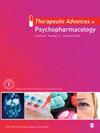Using in silico methods to determine optimal tapering regimens for decanoate-based long-acting injectable psychosis drugs
IF 3.4
3区 医学
Q2 PHARMACOLOGY & PHARMACY
引用次数: 0
Abstract
Background:Reducing the dose of psychosis drugs in a gradual hyperbolic manner may minimise withdrawal effects and risk of relapse. There is presently limited guidance on tapering decanoate-based long-acting injectable dopamine antagonists (LIDAs).Objectives:We aimed to apply hyperbolic principles of tapering to the decanoate-based LIDAs flupentixol, zuclopenthixol and haloperidol to develop withdrawal regimens.Design:We used in silico methodology to predict plasma drug levels and D利用硅学方法确定癸酸盐类长效注射型精神病药物的最佳减药方案
背景:以渐进的双曲线方式减少精神病药物的剂量,可以最大限度地减少戒断效应和复发风险。目的:我们旨在将双曲线减量原则应用于癸酸类长效注射用多巴胺拮抗剂(LIDA)氟朋噻醇、祖氯朋噻醇和氟哌啶醇,以制定停药方案。设计:我们使用硅学方法预测不同 LIDA 方案的血浆药物水平和 D2 占位率。结果:突然停用癸酸盐类 LIDA 会导致 D2 占有率的过度变化,这违反了我们预先设定的约束条件,可能会导致戒断症状并增加复发风险。减少LIDA剂量可使血浆水平呈双曲线下降,这与受体占有率下降率的限制条件相一致。在每周服用等量 LIDA 的情况下,更频繁地给药可以更渐进地降低 D2 占位率。不过,要想继续双曲线式减量直至完全停药,必须改用口服药物;仅使用 LIDA 将 D2 占位率降至零会导致 D2 占位率下降过多。结论:尽管癸酸酯类 LIDA 与口服制剂相比半衰期更长,但突然停用癸酸酯类 LIDA 与双曲线渐减并不一致。只有通过改用口服疗法来完成减量,才能达到完全停药的程度。这些结果受限于研究的硅学和理论性质,需要通过实际观察和干预研究来证实这些发现。
本文章由计算机程序翻译,如有差异,请以英文原文为准。
求助全文
约1分钟内获得全文
求助全文
来源期刊
CiteScore
7.90
自引率
2.40%
发文量
35
审稿时长
10 weeks
期刊介绍:
Therapeutic Advances in Psychopharmacology delivers the highest quality peer-reviewed articles, reviews, and scholarly comment on pioneering efforts and innovative studies across all areas of psychopharmacology. The journal has a strong clinical and pharmacological focus and is aimed at clinicians and researchers in psychopharmacology, providing a forum in print and online for publishing the highest quality articles in this area.

 求助内容:
求助内容: 应助结果提醒方式:
应助结果提醒方式:


